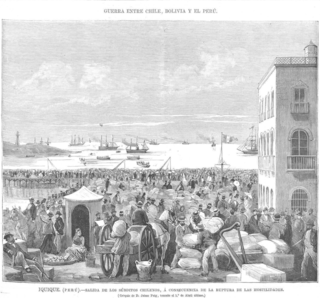
Ceviche, cebiche, sebiche, or seviche is a dish consisting of fish or shellfish marinated in citrus and seasonings, recognized by UNESCO as an expression of Peruvian traditional cuisine and Intangible Cultural Heritage of Humanity, although different versions of ceviche are part of the culinary culture of various Spanish-American countries along the Pacific Ocean where each one is native: Chile, Colombia, Costa Rica, Ecuador, El Salvador, Guatemala, Honduras, Mexico, Nicaragua, Panama and Peru. In Peru it is also considered a flagship dish and cultural heritage.
Pisco is a colorless or yellowish-to-amber colored spirit produced in winemaking regions of Peru and Chile. Made by distilling fermented grape juice into a high-proof spirit, it was developed by 16th-century Spanish settlers as an alternative to orujo, a pomace brandy that was being imported from Spain. It had the advantages of being produced from abundant domestically grown fruit and reducing the volume of alcoholic beverages transported to remote locations.

A pisco sour is an alcoholic cocktail of Peruvian origin that is traditional to Peruvian cuisine and Chilean cuisine. The drink's name comes from pisco, which is its base liquor, and the cocktail term sour, about sour citrus juice and sweetener components. The Peruvian pisco sour uses Peruvian pisco as the base liquor and adds freshly squeezed lime juice, simple syrup, ice, egg white, and Angostura bitters. The Chilean version is similar, but uses Chilean pisco and Pica lime, and excludes the bitters and egg white. Other variants of the cocktail include those created with fruits like pineapple or plants such as coca leaves.

A sour is a traditional family of mixed drinks. Sours belong to one of the old families of original cocktails and are described by Jerry Thomas in his 1862 book How to Mix Drinks.

José Natividad González Parás is a Mexican politician affiliated with the Institutional Revolutionary Party. He is a former federal deputy and former governor of Nuevo León (2003–2009) He is also married to Cristina Maiz
The Carmañola Americana is a revolutionary song composed circa 1797 following the model of the French Carmagnole. In context, it was composed during the independentist movement of Manuel Gual and José María España. The song incited the population to revolt against dictatorial rule, seeking for freedom and independence.

Pica is a Chilean town and commune in Tamarugal Province, Tarapacá Region. Situated in the inland of the Atacama Desert on an oasis, Pica is famous for its small and unusually acidic limes known as Limón de Pica. The town has a communal hot spring with a surface temperature of 40 °C, which makes it a popular bath place in the middle of the desert. It has hotels and all basic services. The town lies four kilometers to the northeast of the oasis village of Matilla.
Marcelo Lipatín López is a Uruguayan professional football (soccer) player.

José María Sanz Beltrán, Loquillo or Loco is a Spanish rock singer. He was born in Barcelona. Beginning in the 1980s, he performed as Teddy Loquillo, and then with the groups Loquillo y los Intocables, and later Loquillo y Los Trogloditas. He started out as a rockabilly artist, and then became more famous mixing pop, punk and rock. He played as a solo act as well as performing with the Trogloditas, but they broke up in 2008. Nowadays, he's a widely recognised solo artist in Spain. He also writes blogs on elmundo.es.

The Cenia is a coastal river in Spain that flows through the eastern part of the Iberian Peninsula. Along a significant portion of its course, it acts as a border between the provinces of Castelló and Tarragona. It has a length of 50 km and it flows into the Mediterranean Sea.

The Expulsion of Chileans from Bolivia and Peru in 1879 was an ethnic cleansing ordered by of the governments of Bolivia and Peru. The expulsion took place at the beginning of the War of the Pacific (1879-1883) between Chile and Peruvian-Bolivian alliance. Chilean citizens in both nations were ordered to leave within eight days or face internment and confiscation of their property. They were expelled on poorly-built rafts and pontoons at Peruvian ports, or forced to wander through the desert to reach the northernmost positions occupied by the Chilean Army in Antofagasta. The edict was widely popular in Peru and met with little resistance, allowing it to occur quickly.

Manuel Arturo Merino de Lama is a Peruvian politician who briefly served as President of Peru for six days between 10 and 15 November 2020. He also served as the President of Congress from 16 March 2020 to 15 November 2020. He was a Member of Congress (AP) representing the Tumbes constituency for the 2001–2006, 2011–2016, and 2020–2021 terms.

Causa limeña or simply causa, is a typical and widespread entrée of the Peruvian gastronomy which has a pre-Columbian origin.
Limón de Pica is an unusually acidic lime from the oasis town of Pica in Atacama Desert. Limóns de Pica have had an appellation of origin since 2010. The environment where the limes are grown has a mild microclimate that does not display the typical high temperature oscillations seen in many of the world's deserts. Six producers, compromising 20% of the agricultural output of the oasis, are organised in Oasis Pica Coop. As of 2019, the coop was working to certify its products as organic and enforce the appellation control of limón de Pica.

The 2022 South American cold wave refers to a series of cold temperatures and non-consecutive drops in temperature that had been recorded from May to November 2022.

The Recapture of Tarapacá or Siege of Tarapacá was a confrontation between Bolivian occupation forces under the command of Colonel José María García and Peruvian militias under the command of Major Juan Buendía within the framework of the War between Peru and Bolivia between January 6 and 7, 1842. Peruvian victory allowed us to recover the province of Tarapacá, which had been captured by Bolivian troops days before.














